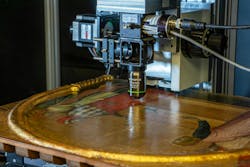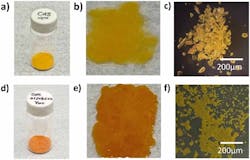Pump-probe microscopy advances artwork restoration
A team from Duke University (Durham, NC) has discovered that pump-probe microscopy is an effective tool for art restoration and, more broadly, preservation of cultural heritage (see video).
“There are many methods, including traditional spectroscopies, applied to cultural heritage, but this has a piece in the toolbox that is unique,” says Dr. Warren S. Warren, a chemistry professor at Duke whose team works in ultrafast laser spectroscopy and pulsed techniques. “Pump-probe microscopy can dramatically separate very similar-appearing compounds by their pump-probe signatures.”
While pump-probe microscopy—a nonlinear optical imaging technique used to study chemical reactions—is well established, the team’s approach involves a mode-locked laser system they developed in the early 2000s. The setup imposes a megahertz amplitude modulation on the pump that is then transferred to the probe.
“This drastically reduces the noise level and makes it possible, in turn, to use much lower power,” Warren says. “We can look at centuries-old paintings at average powers of about 0.1 mW, which is one-15th of a laser pointer.”
The team’s advanced pump-probe microscopy technique, which uses ultrafast laser pulses of near-infrared (IR) light, allows them to identify chemical compounds present in a paint pigment sample without invasive means such as cutting a portion of the artwork. Specifically, their recent work uses a laser on various sections and depths of a cadmium yellow paint sample.
“It’s a truly fascinating pigment,” Warren says. “Unlike many inorganic pigments, which were in common use in Renaissance times, cadmium sulfide is pretty modern (late 19th century), as cadmium is an unwanted byproduct of industrial zinc refining. Its degradation is real, but poorly understood.”
In their work, the researchers subjected several paintings that feature cadmium yellow to an artificial aging process involving exposure to high relative humidity and light. They could then see the 3D structure and degradation progress of cadmium sulfide pigments in oil paints. 3D maps can be created from the chemical fingerprints obtained to more accurately monitor changes, even before they’re visible to the naked eye.
Volumetric imaging is a part of the system, as well, which revealed early cadmium sulfide degradation of small particles and on the surface of large particles. The study overall found that the “particle dimension influences the extent and evolution of degradation of historical cadmium sulfide” in the artwork.
To compare, the team placed several other cadmium sulfide samples in a dry, dark environment that was protected from moisture and potential light damage. These samples remained unchanged, while the exposed samples faded to lighter shades of yellow and showed clear signs of decay within just weeks.
“The big advantage of pump-probe microscopy is that it can dramatically separate very similar appearing compounds by their pump-probe signatures,” Warren says.
Pump-probe microscopy beginnings
Conceptually, pump-probe experiments date back to the beginnings of laser science, Warren explains. The method includes a nonlinear pump laser pulse that perturbs a system by putting population in an electronically excited state and creating a corresponding “hole” in the ground state. The system is then allowed to freely evolve—an evolution that can be complex. For example, the excited population and ground state “hole” can evolve independently, with at least seven different mechanisms reflected in the dynamics.
“Sometimes not being linear is perceived as complicated and something to avoid,” says Martin Fischer, a research professor in Duke’s chemistry department. “But it is exactly this nonlinearity that makes imaging in highly complex materials like skin and paintings more powerful than with conventional linear microscopy methods.”
A second probe laser pulse is also part of the traditional process. It shows some observable changes—in things like transmitted pulse intensity, the induced fluorescence, or the scattered light—as the delay varies, mapping out the intermediate time dynamics.
The researchers say use of amplified laser pulses gains some background suppression by gating the pump pulse to highlight the difference in the probed signal from that pulse. Conventional analysis approaches also require sample removal to obtain microscopic information. When used for artwork restoration, this would mean removing a portion of the painting.
Preserving culture
“The cultural heritage community understands a fundamental dilemma: the inherently transient nature of important works of art,” Warren says, noting that pieces by impressionist artists such as Vincent van Gogh remain extremely important. “We don't want to lose the fruits of their genius.”
Art preservation efforts can advance with the new pump-probe microscopy technique. The team is now working to develop a smaller, portable setup to conduct tests on paintings that are too large and/or delicate to move to an off-site lab.
FURTHER READING
Y. Zhou et al., J. Phys. Photonics, 6, 2, 025013 (Apr. 2024); https://doi.org/10.1088/2515-7647/ad3e65.
About the Author
Justine Murphy
Multimedia Director, Digital Infrastructure
Justine Murphy is the multimedia director for Endeavor Business Media's Digital Infrastructure Group. She is a multiple award-winning writer and editor with more 20 years of experience in newspaper publishing as well as public relations, marketing, and communications. For nearly 10 years, she has covered all facets of the optics and photonics industry as an editor, writer, web news anchor, and podcast host for an internationally reaching magazine publishing company. Her work has earned accolades from the New England Press Association as well as the SIIA/Jesse H. Neal Awards. She received a B.A. from the Massachusetts College of Liberal Arts.



